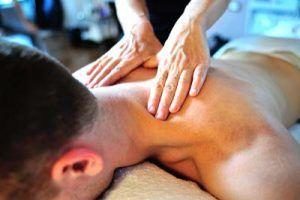Can Massage Therapy Help Reduce Anxiety?
Complementing Chiropractic Care With Massage Therapy
May 8, 2018
Examining at the Stress-Reduction Benefits of Massage
According to the National Institute of Mental Health, approximately 31% of adults in the U.S. will be diagnosed with anxiety disorder at some point in their lifetime. Those living with generalized anxiety disorder (or GAD) often live in a state of constant fear, worry, or despair. GAD can impact one’s day-to-day ability to function, limit quality of life, and is even associated with physical health conditions, such as headaches, muscle pain, irritable bowels syndrome, and sleep disorder.
The most well-known treatment options include therapy and pharmaceuticals, but very few people realize that a growing body of research supports the conclusion that massage therapy can also help to reduce the symptoms of anxiety. While any treatment plan should be discussed in detail with your doctor, let’s look at a few of the reasons you might want to consider adding regular massage in South Hill, WA from Dr. Bob Gregory to your healthcare routine.
Supported by the American Massage Therapy Association
The American Massage Therapy Association (or AMTA) is the largest non-profit organization for massage therapists in the United States. In a 2013 position statement, the AMTA officially announced their stance that massage therapy can benefit those who suffer anxiety by reducing their symptoms.
Citing more than thirty different studies, literature reviews, clinical trials, and other sources, the AMTA found that massage can relieve anxiety caused by a wide range of situations, including the following:
- Anxiety associated with back pain, hand pain, and chronic pain
- Anxiety in cancer, stroke, fibromyalgia, and bone marrow transplant patients
- Anxiety in children with physical and psychiatric illnesses
One of the reasons that massage is so effective at eliminating anxiety is because of its ability to reduce stress. Massage typically involves at least thirty minutes of complete escape from the normal stressors of life. During this time, your sole focus is on relaxing yourself and being relaxed by a professional massage therapist. Those plagued with anxiety often feel as if their brains are constantly giving them new things to worry about. Massage allows them to slow down, breathe, and quiet their minds.
Swedish Massage Can Benefit Patients with General Anxiety Disorder
A randomized study published in the Journal of Clinical Psychiatry concluded that Swedish massage “is an effective acute treatment for GAD [General Anxiety Disorder]”. Swedish massage involves five primary techniques: vibration, kneading, rolling, tapping, and percussion—all of which combine to reduce stress, a common side effect of anxiety.
This clinical trial followed the experiences of forty patients who had been diagnosed with GAD but had not yet received any medical treatment for their anxiety. Half of the participants received a 45-minute Swedish massage twice per week for six weeks. The other half (the control group) received only a light touch massage at the exact same intervals.
The subjects were measured before and after the trial using the Hamilton Anxiety Rating Scale (HARS), which rates a participants level of anxiety with a score from 0 to 56. By the end of the six weeks, the Swedish massage group had reduced their HARS score by 3 more points than the control group, a difference statistically significant enough to recommend Swedish massage as a promising method of reducing the symptoms of anxiety.
Massage is Just as Effective as Other Alternative Treatments
Another study, published in Depression and Anxiety, compared massage therapy to two other alternative anxiety treatments: thermotherapy and relaxation rooms. In this study, 68 participants received one of the three types of treatment regularly over a 12 week period.
The massage group received a special treatment created by an osteopathic psychiatrist in consultation with several massage therapists and educators. The thermotherapy treatment consisted of administering warm pads and towels to the body while the therapist spoke with patients in an amicable way. The third group simply laid comfortably in a room while music of their choice was played.
Participant anxiety levels were scored using the HARS measurement before treatment, immediately after the 12-week trial, and at a 6-month follow up. All three groups cut their scores in half on average after the trial, and these benefits persisted during the follow-up.
So this study goes to show that massage therapy can significantly reduce symptoms of anxiety just as well as other forms of alternative treatments—and those results were without drugs or therapy.
Is Massage Right for You?
Massage has long been proven to reduce stress and relieve muscle pain. But recent research is finally beginning to recognize the secondary health benefits of regular massage therapy.
Anxiety is a real problem that significantly impacts the quality of life of nearly a third of the U.S. adult population. Those suffering from it deserve every form of relief available. As with any medical condition, you should first check with your primary care physician to decide if massage therapy is a good fit for your anxiety treatment plan.
Dr. Bob Gregory has been providing chiropractic and massage treatment to the people of South Hill for over 20 years. Don’t hesitate to give us a call today to find out how massage fits in with your journey to healthy happy living.
